Discover the fascinating world of yarn as we explore various types of yarn names, perfect for your next knitting or crochet project.
Welcome to my blog about all things yarn! As a passionate crocheter and knitter, I know that choosing the right yarn can make all the difference in the success of a project. One of the most confusing aspects of buying yarn is understanding the different types of yarn names.
From acrylic to wool to alpaca, there are so many options out there! In this blog post, I will break down some common types of yarn names and explain what they mean. Whether you’re a beginner or an experienced crafter, understanding these terms will help you choose the perfect yarn for your next project.
So grab your hooks and needles and let’s dive in!
Wool
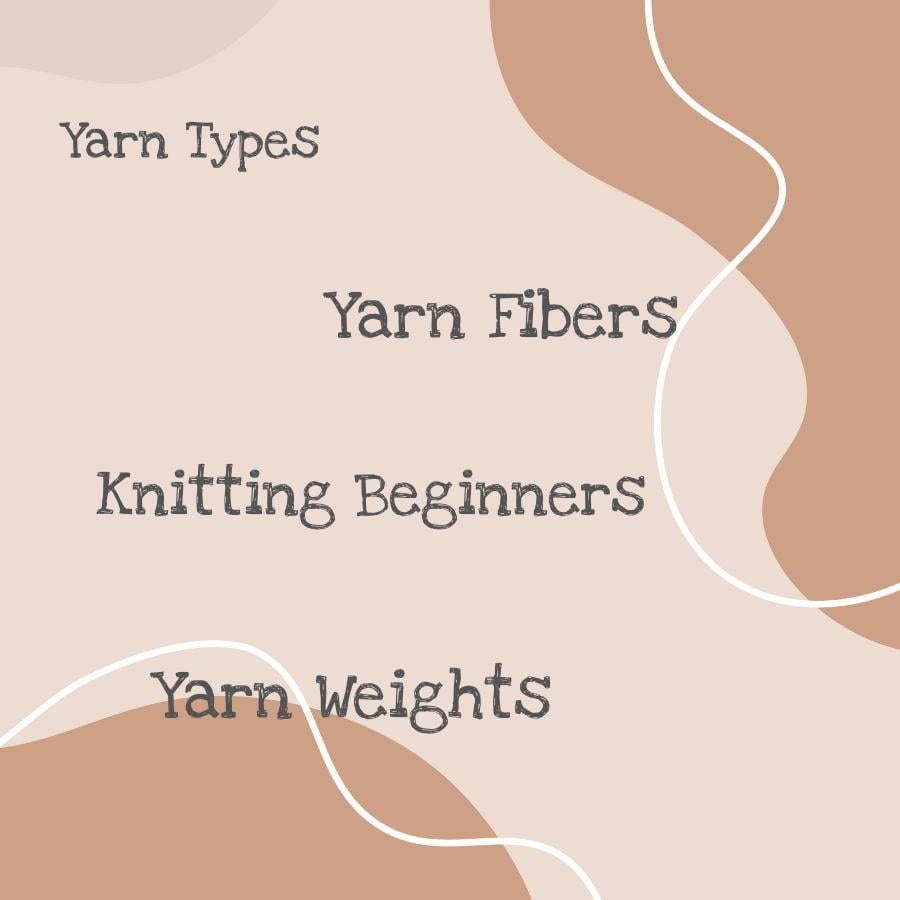
Wool is one of the most popular types of yarn, and for good reason. It’s warm, durable, and comes in a variety of textures.
Wool yarn can be made from different breeds of sheep or other animals like alpacas or llamas. The texture and quality vary depending on the breed used to make it.
Merino wool is one type that’s highly sought after because it’s soft, fine-textured, and doesn’t itch like some other wools do. Shetland wool has a coarser texture but still makes excellent sweaters due to its warmth retention properties.
When shopping for wool yarns look out for terms such as “worsted,” “chunky,” or “fingering” which refer to the thickness (or weight) of the yarn strand itself – this will determine how thick your finished project will be.
Alpaca
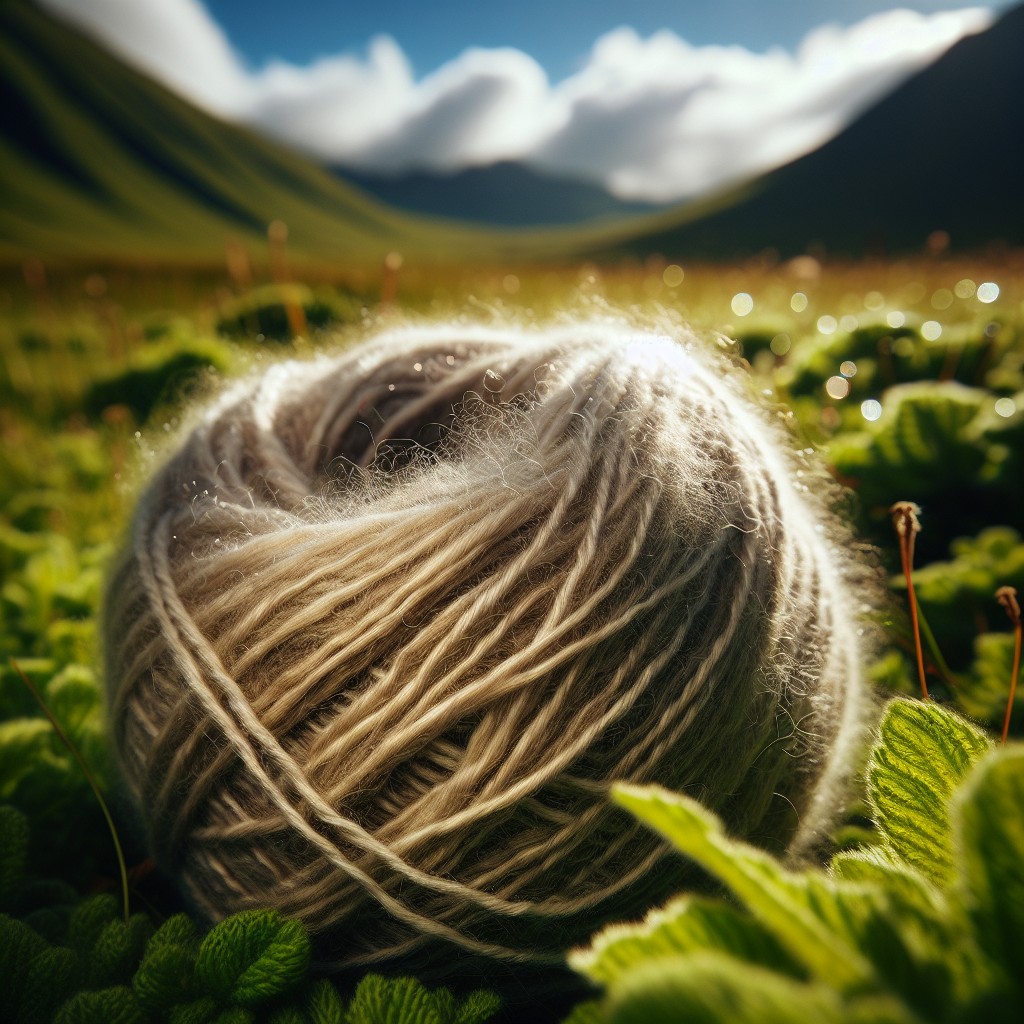
Alpacas are native to South America and their wool has been used for centuries by the indigenous people of the Andes Mountains. The fiber from alpacas is similar in texture to sheep’s wool but it is much softer, making it ideal for clothing items that will be worn close to the skin.
There are two types of alpaca fibers: Huacaya (pronounced wah-KI-ya) which has a fluffy appearance like sheep’s wool; Suri (pronounced SOO-ree), which grows long silky locks that drape beautifully when spun into yarn.
Alpaca yarn comes in various weights ranging from lace weight all the way up to bulky weight. It can be dyed easily with natural or synthetic dyes resulting in beautiful colors that retain their vibrancy over time.
When shopping for alpaca yarn, look out for blends as well as 100% pure varieties. Blends may contain other fibers such as silk or cashmere which add extra softness and sheen while maintaining some of alpaca’s unique properties like warmth retention without being too heavy on your shoulders!
Cashmere
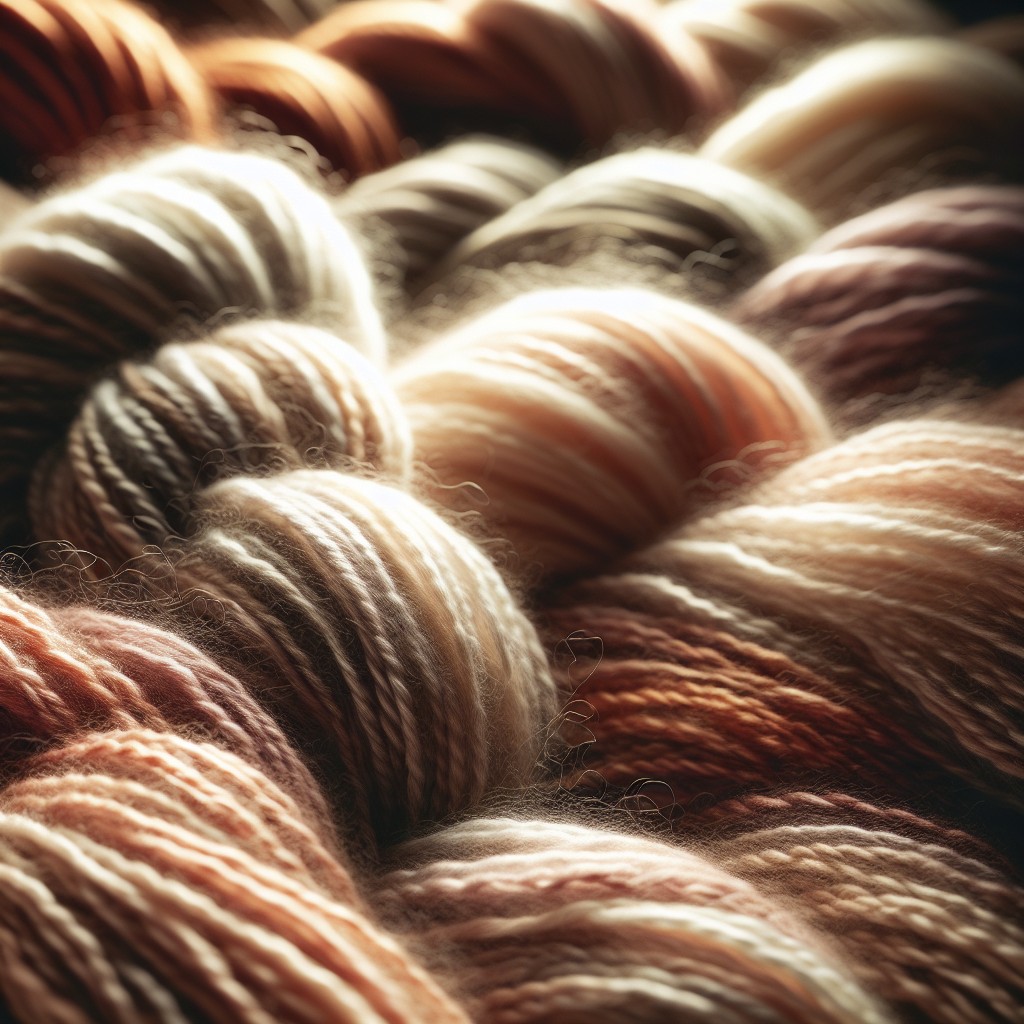
It comes from the soft undercoat of cashmere goats, which are primarily found in Mongolia, China, and Iran. Cashmere is known for its incredible softness and warmth, making it perfect for cozy sweaters or scarves.
One thing to keep in mind when working with cashmere yarn is that it can be quite delicate. It’s important to handle it gently while knitting or crocheting to avoid damaging the fibers.
Because cashmere can be expensive compared to other types of yarns like acrylic or wool blends, you may want to reserve this special fiber for smaller projects like hats or mittens.
When shopping for cashmere yarns online or at your local craft store look out for labels indicating the percentage of pure Cashemere used as well as care instructions such as hand-washing only.
Mohair
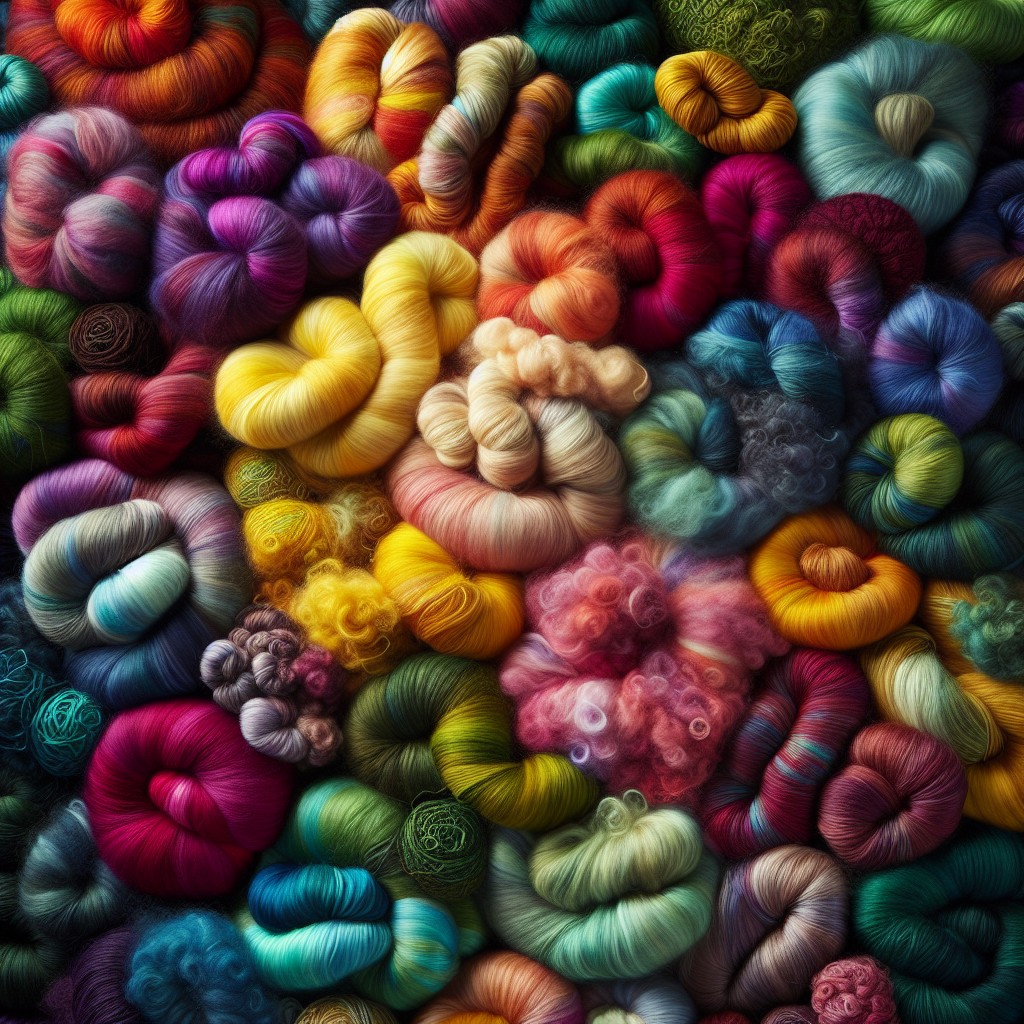
It’s known for its softness, sheen, and durability. Mohair fibers are long and lustrous, which gives it a silky texture that drapes beautifully when knitted or crocheted.
This type of yarn is perfect for creating cozy sweaters, shawls or scarves.
One thing to keep in mind when working with mohair is that it can be quite slippery due to its smooth texture. This means you’ll need to use needles or hooks with good grip so your stitches don’t slip off accidentally.
Another important factor to consider before using mohair in your project is the shedding factor – as this type of fiber tends to shed more than other types like wool or cotton.
Angora
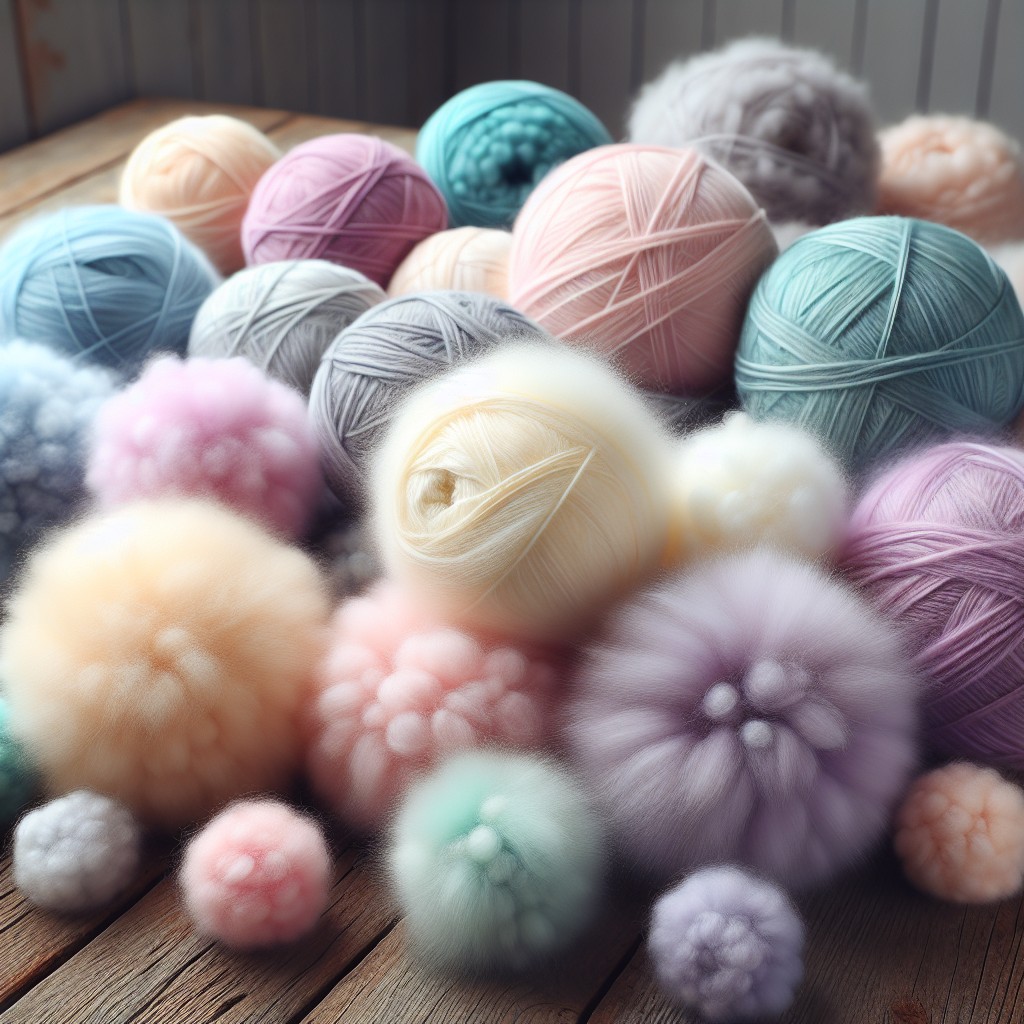
It’s known for its softness, warmth, and fluffiness. Angora yarn can be used to create luxurious garments such as sweaters, scarves, and hats.
One thing to keep in mind when working with angora yarn is that it sheds quite a bit. This means you’ll need to be careful not to get fibers all over your clothes or workspace while knitting or crocheting.
Despite this minor inconvenience, many crafters love using angora because of its unique texture and appearance. It’s also worth noting that there are different types of angora yarn available on the market – some are pure angora while others may contain other fibers like wool or nylon.
Llama
Llama wool is hypoallergenic, making it a great choice for those with sensitive skin. It’s also naturally water-resistant and flame-retardant, making it an excellent option for outdoor wear like hats or mittens.
One of the unique features of llama yarn is its natural range of colors. From creamy whites to rich browns and grays, you can find llama yarn in a variety of shades without any dyeing required.
When working with llama yarn, keep in mind that it can be slightly coarser than other types of animal fibers like cashmere or alpaca. However, this makes it more durable and less likely to pill over time.
Cotton
It’s easy to work with, making it perfect for beginners, and comes in a variety of weights and colors. Cotton yarn is also durable, machine washable, and hypoallergenic.
One of the benefits of cotton yarn is that it doesn’t have any stretch or elasticity like other fibers such as wool or acrylic. This makes it ideal for projects where you want your stitches to hold their shape well over time.
Another advantage of cotton yarn is that it’s breathable which makes garments made from this fiber comfortable even in warm weather conditions. Cotton can be blended with other fibers such as silk or linen to create unique textures while still maintaining its durability.
When working with cotton yarns keep in mind that they tend not to drape well compared to some other types like silk; therefore they are best suited for items like dishcloths or bags rather than scarves.
Silk
It’s made from the cocoon of the silkworm, which is carefully unraveled to create long, smooth fibers. Silk yarns are known for their lustrous sheen and soft drape, making them perfect for creating delicate garments like shawls or scarves.
One thing to keep in mind when working with silk yarns is that they can be slippery and difficult to control on your needles or hook. However, this also means that they have excellent stitch definition – every detail will show up beautifully in your finished project.
Silk blends are also popular among crafters as it adds strength while maintaining its natural shine and texture. Some common silk blends include wool-silk blend (for warmth), cotton-silk blend (for breathability), bamboo-silk blend (for sustainability) among others.
Linen
It’s made from the fibers of the flax plant and is known for its strength, durability, and coolness. Linen yarn can be used to create a wide range of projects such as summer tops, lightweight scarves or shawls.
One thing to keep in mind when working with linen yarn is that it tends to be stiff at first but softens up after washing. Linen doesn’t have much elasticity compared to other types of fibers like wool or cotton which makes it less forgiving if you make mistakes while knitting or crocheting.
Despite these challenges though, many crafters love using linen because it creates beautiful finished products with great stitch definition and drape.
Bamboo
This type of yarn is made from bamboo grass, which grows quickly and sustainably without the need for pesticides or fertilizers. Bamboo fiber has many benefits that make it an excellent choice for crafting projects.
It’s soft, lightweight, breathable, and moisture-wicking properties make it perfect for summer garments like tank tops or shawls.
Bamboo yarn also drapes beautifully when used in larger projects such as blankets or scarves. Its natural sheen gives finished items a luxurious look while still being affordable compared to other luxury fibers like silk.
One thing to keep in mind when working with bamboo yarn is that its lack of elasticity can cause some issues with tension if you’re not careful. However, this can be easily remedied by using smaller needles than what would typically be recommended based on the weight category.
Hemp
It’s an eco-friendly option for yarn because it requires less water and pesticides to grow than cotton. Hemp yarn has a rough texture, making it perfect for items like dishcloths or bags that need to be durable and sturdy.
It also has anti-bacterial properties, which makes it great for kitchen items.
One thing to keep in mind when working with hemp yarn is that it can be stiff at first but will soften over time with use and washing. You may want to consider blending hemp with another softer fiber like cotton or silk if you’re looking for something more comfortable against your skin.
Acrylic
It’s made from synthetic fibers, which means it’s easy to care for and can be machine washed without losing its shape or color. Acrylic yarn comes in a wide range of colors, making it perfect for creating vibrant projects like blankets, scarves, hats, and more.
One of the benefits of acrylic yarn is that it doesn’t shrink or felt like natural fibers such as wool do. This makes it an excellent option if you’re looking to create items that will withstand frequent use or washing.
Another advantage of acrylic yarn is that it’s hypoallergenic – great news if you have sensitive skin! Unlike some natural fibers such as wool or mohair which can cause itching and irritation on the skin when worn next-to-skin.
While there are certainly pros to using acrylic yarns in your knitting/crochet projects; one downside could be their lack of breathability compared with other types (such as cotton). However this isn’t always an issue depending on what type project you’re working on!
Polyester
It’s often used in yarn blends because it’s durable, easy to care for, and affordable. Polyester yarns are available in a wide range of colors and textures, making them perfect for all kinds of projects.
One advantage of polyester yarn is its resistance to wrinkles and shrinking. This makes it ideal for items like blankets or clothing that will be washed frequently.
Polyester fibers can be blended with other materials such as cotton or wool to create unique textures.
However, some crafters may find the texture of pure polyester yarn too stiff or scratchy compared to natural fibers like wool or silk. If you’re looking for an eco-friendly option when choosing your next project material then this might not be the best choice since it’s made from petroleum-based products which aren’t biodegradable.
Rayon
It’s often used as a substitute for silk because it has similar properties but at a lower cost. Rayon can be found in many different forms, including viscose rayon and modal rayon.
Viscose rayon is the most common type of rayon and it’s known for its softness, drape, and breathability. Modal rayons are more durable than viscose ones.
One thing to keep in mind when working with Rayons is that they tend to stretch out over time if not handled properly during washing or drying processes; therefore, hand-washing your finished project may be necessary.
Nylon
It’s known for its strength, durability, and elasticity. Nylon yarn is often used in knitting and crochet projects because it holds up well over time and can withstand wear and tear.
One of the benefits of using nylon yarn is that it’s easy to care for. It can be machine washed on a gentle cycle with cool water, making it ideal for items like socks or baby clothes that need to be washed frequently.
Another advantage of nylon yarn is its affordability compared to natural fibers like wool or silk. This makes it an excellent choice for beginners who are just starting out with knitting or crochet but still want high-quality results.
When choosing nylon yarn, look for brands that offer a wide range of colors so you can find the perfect shade for your project. You’ll also want to pay attention to the weight category as different weights will produce different results depending on what you’re making.
Yarn Fiber Blends
Yarn fiber blends can offer the best qualities of each individual fiber while minimizing their drawbacks. For example, wool and silk blend together to create a luxurious yarn that is soft and warm but also has a beautiful sheen.
Commonly used blended fibers include cotton-polyester, wool-acrylic, alpaca-silk-wool-cashmere (also known as luxury blends), bamboo-cotton-nylon-spandex (for stretchy socks), among others.
When choosing a blended yarn for your project, consider what you want the finished item to look like and how it will be used. A blend with nylon or polyester may be better suited for items that need durability such as socks or blankets while cashmere-silk-alpaca might work well in delicate shawls.
Novelty and Specialty Yarn Types
These types of yarns are often made with unusual materials or textures that can add interest to your project. Some popular examples include eyelash yarn, which has long strands that resemble eyelashes; ribbon yarn, which is flat and wide like a ribbon; and boucle yarn, which has loops woven into it for added texture.
While these types of novelty and specialty yarns can be fun to work with, they do require some special considerations when it comes to choosing patterns. Because the texture of the yarn itself is such an important part of the finished product’s look and feel, simpler patterns tend to work best.
When working with these kinds of fibers in particular (eyelash being one example), take care not only in selecting appropriate knitting needles but also pay attention while knitting as stitches may be harder than usual to see due their fluffiness.
Yarn Type Comparison Chart
One of the most important is the type of fiber used in the yarn. Each fiber has its own unique properties that affect how a finished project will look and feel.
To help you make an informed decision, I have created a Yarn Type Comparison Chart that breaks down some common types of fibers used in yarn and their characteristics.
The chart includes information on wool, alpaca, cotton, silk, linen and more! It also covers synthetic fibers like acrylics and polyesters which can be great options for those with allergies or who prefer vegan-friendly materials.
By using this comparison chart as a reference guide when shopping for your next skein or ball of yarn you’ll be able to choose one that’s perfect for your needs based on texture preferences (smooth vs fuzzy), warmth level desired (lightweight vs bulky) as well as durability requirements such as washability or resistance against pilling.
Yarn Textures and Why They Matter
The texture of a yarn can affect how easy or difficult it is to work with, how well-defined your stitches will be, and even the overall look of your finished project.
Some common textures you may encounter include smooth (also known as “plain”), boucle (which has loops that create a bumpy surface), chenille (a soft and fuzzy texture), ribbon (flat strips woven together), and eyelash (with long strands that resemble lashes). Each type of texture creates its own unique effect when worked up into a project.
For example, if you’re making something like a scarf or blanket where warmth is key, you might want to choose a bulky weight yarn with lots of loftiness for extra coziness. On the other hand, if you’re working on something more delicate like lacework or intricate cables in knitting patterns for beginners , then using smoother textured yarns would help show off those details better.
Ultimately though it all comes down to personal preference – some people love working with textured novelty yarns while others prefer simpler options.
Yarn Weight Categories & Conversion Explained
Yarn weight refers to the thickness of the strand and can vary from very fine (laceweight) to super bulky. Each category has a recommended hook or needle size, making it easier for you to choose which one will work best with your pattern.
The Craft Yarn Council has established standard guidelines for yarn weights that are recognized by most manufacturers and crafters alike. These guidelines include seven main categories: laceweight, fingering/socks, sport/baby, DK/light worsted, worsted/aran/heavy worsted), bulky/chunky and super bulky/jumbo.
It’s important to note that not all manufacturers follow these standards exactly so be sure always check gauge before starting any project. If you have a pattern calling for a specific type of yarn but only have another type on hand don’t worry! You can use this handy conversion chart as reference:
Lace – 0 Fingering/Sock – 1 Sport/Baby – 2 DK/Light Worsted -3 Worsted/Aran/Heavy Worsted-4 Bulky /Chunky-5 Super Bulky/Jumbo-6.
The Different Yarn Weights
It determines how thick or thin the yarn is and affects the drape, texture, and overall look of your finished piece. Yarn weights are categorized into different groups based on their thickness.
The most common categories include lace, fingering/socks, sport/DK (double knitting), worsted/aran (medium), bulky/chunky (thick) and super bulky/jumbo (extra-thick). Each category has a recommended needle size range that works best with it.
It’s important to note that not all brands follow these standards strictly; some may have slight variations in their thicknesses within each category. Therefore it’s always advisable to check the label for specific recommendations before purchasing any yarn.
Understanding different types of yarn weights will help you choose appropriate patterns as well as needles/hooks sizes required for each project.
Yarn Fibers And Composition
The type of fiber used in a yarn can affect its texture, drape, and durability. Some fibers are soft and fluffy while others are more sturdy or have a sheen.
Understanding different types of fibers will help you choose the right yarn for your project.
Wool is one of the most popular natural fibers used in knitting and crochet projects because it’s warm, durable, elastic and has great stitch definition. Alpaca wool is also very popular due to its softness but with less elasticity than sheep wool.
Cashmere comes from cashmere goats’ undercoat hair; this luxurious fiber feels incredibly soft against your skin but can be quite expensive compared to other types.
Mohair comes from Angora goats’ long curly locks; this fuzzy material adds an interesting texture when blended with other materials like silk or cotton.
Angora rabbit fur produces angora which creates a halo effect on finished items that gives them extra warmth without adding weight. Llama wool has similar properties as alpaca since they belong in same family group Camelidae.
Cotton makes lightweight garments perfect for summer wear due to their breathability qualities while silk provides shine making any garment look elegant yet delicate at touch.
Linen made from flax plant fibres offers excellent moisture-wicking properties making it ideal for hot weather clothing such as beachwear.
Bamboo fibre blends offer eco-friendly options that feel silky smooth against your skin while hemp fibres provide strength when mixed with cotton creating durable fabrics suitable for bags or home decor items.
Tools To Use With Yarn For Beginners
But don’t worry, I’ve got you covered! Here are some essential tools that every beginner should have in their arsenal:.
1. Crochet hooks or knitting needles: These are the most important tools for any yarn project.
Choose the right size based on your pattern and yarn weight.
2. Scissors: You’ll need scissors to cut your yarn at various points throughout your project.
3. Stitch markers: These little plastic rings help mark where certain stitches begin and end so that you don’t lose track of where you’re at in a pattern.
4. Tapestry needle: This is used for weaving in ends once your project is complete.
5.Measuring tape or ruler : It’s important to measure gauge before starting any crochet or knit projects.
6.Yarn bowl : A Yarn bowl keeps balls of wool from rolling around while crocheting/knitting.
Knitting Patterns for Beginners
As a beginner, it’s important to start with simple patterns that will help you master the basics of knitting. Scarves and dishcloths are great projects for beginners because they only require basic stitches like knit and purl.
There are many free knitting patterns available online, so take some time to browse through them until you find one that catches your eye. Look for patterns labeled “beginner” or “easy” and read through the instructions carefully before starting.
If you’re feeling overwhelmed by written instructions, there are also many video tutorials available on YouTube that can guide you step-by-step through the process of creating different stitches and completing various projects.
How To Knit A Hat With Straight Needles
But fear not! With the right tools and some basic knowledge, anyone can knit a cozy hat with straight needles. Here’s how:
First, choose your yarn and needles based on the pattern you want to follow. Make sure they are compatible in terms of weight and size.
Next, cast on enough stitches for your desired hat circumference (usually around 80-100 stitches). Use a rib stitch or another stretchy stitch for the brim of the hat.
Once you’ve completed several rows of ribbing, switch to stockinette stitch (knit one row then purl one row) until your piece measures about 7-8 inches from the brim.
Now it’s time to decrease! Divide your stitches evenly onto two needles and use K2tog (knit two together) or P2tog (purl two together) every few stitches until only a few remain. Cut off excess yarn leaving about six inches tail before pulling through remaining loops with tapestry needle.
Finally sew up any gaps at top by weaving in ends using tapestry needle; tie knot securely inside so that it doesn’t come undone later when washing garment.
Simple Knitting Stitches For Beginners
Luckily, there are many simple knitting stitches that are perfect for beginners! These basic stitches will help you get comfortable with the motions of knitting and purling while creating a beautiful finished product.
One of the easiest stitches is garter stitch, which involves simply alternating knit rows and purl rows. This creates a bumpy texture that’s great for scarves or dishcloths.
Another beginner-friendly option is stockinette stitch, which alternates between knit rows and purl rows but creates smooth “v” shapes on one side and bumpy ridges on the other. This makes it ideal for projects like hats or sweaters where you want one side to look different from the other.
Seed stitch is another easy-to-learn pattern that involves alternating knits and purls in each row but switching their placement every time so they create little bumps all over your work.
FAQ
What are the 3 types of yarn?
The 3 types of yarn are Animal Fibers, Plant Fibers, and Synthetic Fibers.
What is the strongest yarn?
The strongest yarn is nylon, as it has incredible durability and elasticity among all fibers present in yarns.
What is the most popular type of yarn?
The most popular type of yarn is worsted yarn, as it is the most commonly used, medium-thickness, and ideal for outdoor wear or winter garments such as hats and thicker sweaters.
What are the differences between natural and synthetic yarns?
Natural yarns are made from animal or plant fibers, whereas synthetic yarns are derived from man-made materials such as petroleum-based products.
How does yarn weight affect the final outcome of a knitting or crochet project?
Yarn weight significantly influences the final outcome of a knitting or crochet project by determining its thickness, texture, and the time required to complete it.
Which types of yarn are best suitable for specific projects, such as clothing, home decor, or crafts?
Answer: For clothing, choose soft and breathable yarns like cotton and merino wool; for home decor, opt for durable and sturdy yarns like acrylic and polyester; and for crafts, use versatile and easy-to-manipulate yarns like acrylic or cotton blends.
